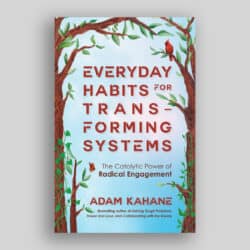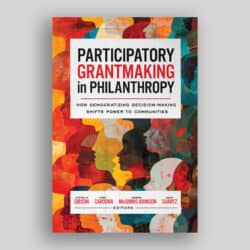Edited by Rachel Laforest. McGill-Queen’s University Press, Montréal, qc & Kingston, on isbn 978-1-55339-132-6
Elizabeth Mulholland
The New Federal Policy Agenda and the Voluntary Sector—On the Cutting Edge is a collection of seven academic essays emerging from a 2006 conference organized by the Queen’s University School of Policy Studies’ Public Policy and the Third Sector Initiative.
The book’s avowed aim is to “provide a venue to foster knowledgeable debate” on “how the federal government and the voluntary sector can work together under a Conservative regime and take forward lessons learned over the past decade to continue to engage a voluntary sector that is creative, innovative and collaborative.”
Given the fuzziness of this goal, it’s difficult to say whether this book actually hits its mark. What it does do quite successfully, however, is provided a multi-faceted look at how successive federal governments have viewed the voluntary sector and the sector’s own role in federal policy making, with a strong focus on the Chrétien, Martin, and early Harper years.
The book’s essays can be grouped into three categories. The first category includes essays by Susan Phillips and Rachel Laforest, which open and close the book respectively. These are high-level, conceptual commentaries on the interaction between the sector and the federal government.
In her essay, Susan Phillips sums up the Conservative government’s voluntary sector balance sheet. Under assets, she lists more generous tax incentives for charitable giving and the Blue Ribbon Panel on Grants and Contributions. Under liabilities, she cites deep cuts to former Liberal initiatives, advocacy and research. Phillips cautions against nostalgia for kinder, gentler governments of the past, however, on the basis that current cuts are no different than those administered by previous Conservative and Liberal governments.
What Phillips and other authors in this volume repeatedly ignore is the difference between cuts made in periods of deficit, that are shared across all sectors of society, and those that are surgically administered in times of plenty to only a select few. Doing without when all around you are in the same boat is unpleasant, but it is a qualitatively different experience than going without when all around you are not. A cut is admittedly still a cut but, when judging governments, a more nuanced view would take fiscal context and other motivating factors into account, as mixed as they might prove.
Phillips goes on to assert that no Canadian government has fully come to terms with the role of the voluntary sector in Canada’s governance and, in the absence of “big ideas,” they have all limited themselves to an “instrumental” view of voluntary organizations, focusing on matters of relationship, grants and contributions, regulation, etc. In short, they “have failed to pay serious attention to the sector.”
Judging from this and other perspectives in this book, it is somewhat de rigeur to ignore the very real differences in how governments relate to voluntary organizations and the sector as a whole and, instead, to invite the proverbial “pox on all their houses” because they all refuse to meet the voluntary sector on a more existential level. The reality is that the voluntary sector should not wait with bated breath to be engaged by this or any other government on the broader existential question of its role in Canadian governance. Governments as a whole are notoriously averse to these types of questions—except, apparently, in the UK and rather mysterious “other countries” as this book frequently reminds us.
Governments do differ significantly, however, in the degree to which they see voluntary organizations as a help versus a hindrance and in the extent to which they appreciate the need for cross-sectoral engagement and collaboration to address complex societal challenges.
Voluntary organizations experience these differences in acutely tangible ways that impact directly on their capacity to fulfill their missions and the degree to which they can actively participate as policy contributors. These differences also affect whether it is even possible to hold a conversation with the federal government on issues affecting the sector as whole. While it is both legitimate and necessary to take stock of shortcomings as well as progress in the voluntary sector’s evolving relationship with the federal government, emphasizing the former while ignoring the latter completely is a sure way to irreversibly poison the relationship. To quote Voltaire, “Perfect is the enemy of the good.”
Phillips goes on to discuss some of the more philosophical elements that would inform a more ideal voluntary sector/federal government relationship. These include the autonomy of the sector, its relationship to citizens and community, and its role in democracy and governance. These are complex questions that Phillips has time to touch on only briefly, but by raising them she performs an enormous service, peeling back the lid on many of the fundamental assumptions that underpin the voluntary sector’s claim to be an essential voice in Canada’s democratic and governance processes.
In the process, she also reveals one of the recurring flaws in this book—conflating the sub-sector involved with social policy and the voluntary sector as whole. The voluntary sector includes tens of thousands of sport, recreation, arts, education, cultural, and religious organizations that would find it very hard to claim they serve as the voice of vulnerable Canadians or are an essential cog in our democratic processes. What they might say is that they enrich the quality of life in our communities, foster civic participation and inclusion, provide opportunities for Canadians to develop all aspects of their human potential, and contribute to the expression of our diverse and shared identities.
Many voluntary organizations do play a critical role in bringing the voices of more Canadians to bear on policy questions that affect them. The participation of many voluntary organizations in policy making does improve our governance, and some voluntary organizations play a valuable role in broadening and deepening our democratic processes. The voluntary sector is extremely diverse, however, and we should not be claiming that these functions are characteristic of the sector as a whole or even the majority of organizations.
Phillips takes aim on numerous occasions at the Chrétien government’s Voluntary Sector Initiative (VSI) as evidence of the government’s failure to engage seriously with the sector’s real concerns. She is right in pointing out that the VSI failed to live up to many of our expectations—those of both government and the voluntary sector. However, one of the primary flaws of the VSI was the failure of all parties to connect with grassroots voluntary organizations and to ensure that their issues were front and centre in the process. Instead, the process was dominated by the preoccupations of national organizations, some of which were linked to the interests of the vast majority of organizations but many of which had little resonance outside the Ottawa “beltway.” In federal Cabinet discussions of the VSI, I was often struck that Ministers seemed to be more attuned to the needs of grassroots organizations in their ridings than the VSI was. Not surprisingly, Ministerial interest in the VSI—and support for it—faded as Ministers realized these needs were not being addressed.
By reminding us of the representational and democratic claims we often make on behalf of our sector, Phillips provides us with a timely reminder that, if we want governments to take this aspect of our role seriously, we must get better at being the change we want to see—modelling the participatory engagement and policy development processes we expect from government within our own organizations.
The second category of essays—by Luc Thériault, Neil Bradford, Grant Holly, and Jehad Aliweiwi/Rachel Laforest—invites the reader to examine the voluntary sector/federal government relationship through a historical lens focused on changing federal policies with respect to child care, cities, the social economy, and immigration. Overall, these essays provide straightforward and highly readable chronological accounts of policy change in particular sectors under successive federal governments. They are interesting for what they tell us about the realities of major social/urban policy change in a federal system and the resilience of policy champions from all sectors that continually adapt their strategies and tactics to meet each new set of challenges.
For the most part, these essays illustrate, rather than reflect on, the changing role of voluntary organizations in federal policy making, providing another illuminating facet to the central theme of the book. The exception is Bradford’s essay on urban policy, which uses an analytic framework that privileges governance and, therefore, has more to say on the question of the sector’s role in policy making under the last three federal regimes. Specifically, Bradford uses the concepts of deep federalism and open federalism to analyse the evolution of urban policy under Chrétien, Martin, and Harper. Deep federalism refers to a preference for multi-level, joined-up governance, and open federalism to a more Cartesian approach that valorizes strict federal and provincial adherence to distinct, non-overlapping jurisdictional spheres and managerial efficiency.
Each of these approaches has its advantages and disadvantages. However, the scope of the voluntary sector’s policy role under any given government is largely determined
by where that government falls on the spectrum between these two approaches. At one end, voluntary organizations are vital actors (individually and sectorally) in vertical and horizontal policy making and governance processes. At the other, they are contracted delivery agents who may or may not be consulted on policy and program questions. In Bradford’s view, Canada did not yet fall squarely into one bucket or the other in 2006 and, consequently, might well have chosen a middle way between the two. Clearly, however, we now live closer to the Cartesian, high efficiency end of this spectrum with all that this entails.
Andrew Graham’s essay is a largely prospective look at potential avenues for increasing the financial sustainability of the sector and, therefore, sits in a category of its own. This essay was the greatest disappointment of the book, which is too bad because it offered the most promise for those interested in ideas on how to move forward in the context of the current federal government. Instead, it offers a confused and confusing treatment of sustainability issues and opportunities, devoid of any empirical data or research that one would expect in any strategic assessment of where the sector’s real opportunities for sustainability lie. Its examination of the political context, various financing options, and the complex tax and regulatory issues involved is shallow, haphazard, and simplistic. One is forced to ask how this essay made it past the editor, as it does not reflect the level of scholarship and writing of the book’s other contributors.
The book’s concluding essay by its editor, Rachel Laforest, provides a valuable summary of the key trends and directions identified in the other essays and arrives at the same point articulated by Susan Phillips at the book’s outset—calling on the federal government to establish a “big picture framework for future direction” or risk falling into the trap of incremental change and succumbing to “policy fads” such as the communities agenda and the social economy.
I suppose that in policy, like all things, beauty lies in the eye of the beholder, but I find it difficult to understand why incremental progress on bread and butter issues, and some quite complex regulatory challenges, should be seen as a bad thing by the voluntary sector. I’m equally perplexed by the notion that governments should not entertain and test new ideas. All policies ultimately become fads if one waits long enough. However, anyone who has spent 10 minutes in politics can tell you that the community’s agenda is here to stay, in some form or another, regardless of which government is in power. Equally, the social economy, known as social enterprise outside of Quebec, continues to be a going concern.
Laforest’s best advice is that voluntary organizations reorient their policy and advocacy efforts, where possible, toward provincial and municipal governments. This is a sound response to the new alignment of federal-provincial responsibilities and the declining relevance of the federal government in social policy. However, Laforest quite rightly points out that it requires the voluntary sector to invest in strengthening its infrastructure at the provincial level, where it is weak in some cases.
In conclusion, this book provides few new insights into how the voluntary sector can secure a strong place in the current federal policy making process; however, this is
hardly a shortcoming. How can one establish a strong place in a process that barely exists? What this book does do is situate the voluntary sector’s current predicament in a broader historical context, helping us to see the similarities and differences in how diverse governments have approached their relationship with the sector and articulated its role. This context setting is critical to our ability to periodically step back and assess where we have gained and lost, and where we can best place our bets for the future. In this respect, Dr. Laforest and the book’s contributors have done the voluntary sector a great service and deserve our thanks.
Elizabeth Mulholland is an independent public policy consultant working in Toronto.
2 Carlton St., Suite 600, Toronto on m5b 1j3.


